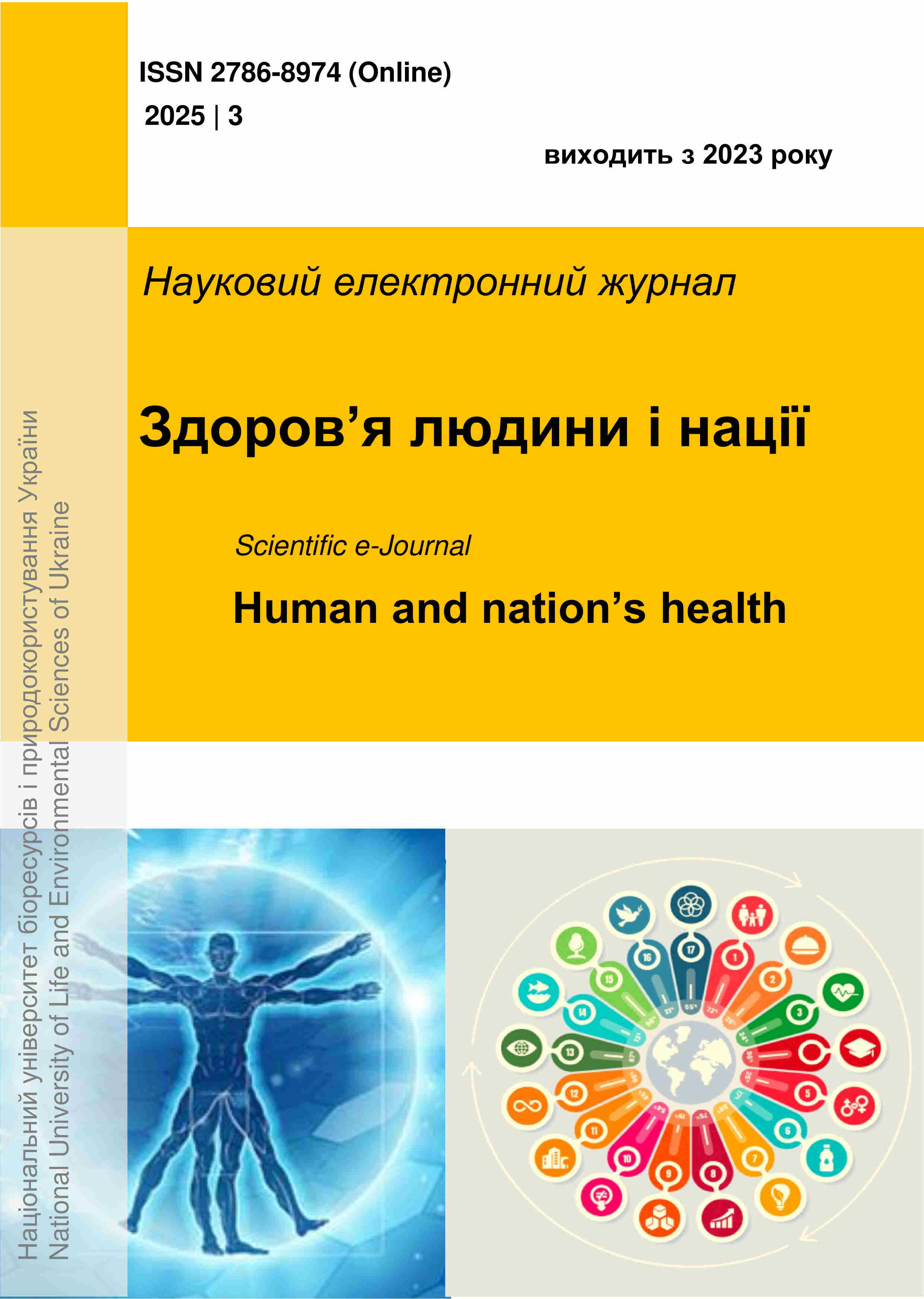COMPREHENSIVE MODEL OF RISK MANAGEMENT SYSTEM: STRUCTURAL AND FUNCTIONAL APPROACH
DOI:
https://doi.org/10.31548/humanhealth.3.2025.49Keywords:
hygienic practice, prerequisite programs, methodology, documentation, animal feedAbstract
Ensuring the safety of animal feed throughout its circulation is a critically important component of the overall food safety management system. Feed, as the initial element of the food chain, directly affects the quality of animal-derived food products, which is reflected in the conceptual slogan "Feed as part of the food chain"
In light of the provisions of the Codex Alimentarius Commission document CAC/RCP 1-1969 (Rev.4-2003), particular emphasis is placed on adherence to Good Hygienic Practice (GHP) at all stages of feed circulation. For enterprises engaged in the circulation of feed, feed additives, and premixes, the implementation of sanitary, infrastructural, transportation, and storage requirements is of critical importance.
This article analyzes and systematizes the elements of the hygienic practice system implemented at “SYMEDICA UA” in the context of feed safety standards and identifies the key factors for effective contamination risk management. The research employed structural-functional analysis, monitoring methods, and graph-analytical tools to visualize zoning of production areas and logistics schemes. A comprehensive set of GMP measures has been implemented, including territorial zoning, color-coded warehouse areas, infrastructure maintenance, implementation of Standard Operating Procedures (SOPs), and personal hygiene requirements for both staff and visitors. Particular attention is given to vehicle inspection prior to loading and the development of logistics routes that consider cross-contamination risks. The proposed model of production hygiene organization can be applied by other operators in the animal feed circulation sector. The experience of the company “SYMEDICA UA” serves as an example of a comprehensive approach to feed safety risk management within the framework of international standards ISO 22000:2018 and DSTU ISO/TS 22002-6:2016.
References
Abdessater, M., Fayyad, F., Matta, J., & Karam, L. (2023). Assessment of prerequisite programs implementation at food packaging manufacturing companies and hygiene status of food packaging in a developing country: Cross-sectional study. Heliyon, 9(9), e19824.
https://doi.org/10.1016/j.heliyon.2023.e19824
British Standards Institution. (2011). Prerequisite programmes for food safety in the manufacture of food and feed for animals (PAS 222:2011).
C.A.F. de Oliveira, A.G. da Cruz, P. Tavolaro, C.H. Corassin (2025). Chapter 10 - Food safety: good manufacturing practices, sanitation standard operating procedures, hazard analysis, and critical control point. Antimicrobial food packaging (second edition). 163-173. https://doi.org/10.1016/B978-0-323-90747-7.00011-9.
Codex Alimentarius Commission. (2003). General principles of food hygiene: CAC/RCP 1-1969, Rev. 4 (2003). Rome, Italy: Food and Agriculture Organization of the United Nations & World Health Organization. https://www.fao.org/3/y1579e/y1579e03.htm
Codex Alimentarius Commission. (2004). Code of practice on good animal feeding (CAC/RCP 54-2004). Rome, Italy: Food and Agriculture Organization of the United Nations & World Health Organization. http://www.codexalimentarius.net/download/standards/10080/CXP_054e.pdf
Crivei, I.C. et al (2025). Advanced risk and hazard analysis in the egg sorting-packing units industry from supplier selection to delivery in chain stores under global food safety initiative integrated food safety programs. Heliyon,11(4), e42587 https://doi.org/10.1016/j.heliyon.2025.e42587
Degtyarev M.O., Yatsenko I.V., Zheynova N.M., Degtyarev I.M. (2020). Analysis of risks in the production of food products. Digit Print.
FAMI-QS. (2014). European code of practice for feed additive and premixture operators (Version 5.1). Brussels, Belgium: FAMI-QS Asbl. http://www.fami-qs.org/documents/codeofpractice.pdf
Food and Agriculture Organization of the United Nations & World Health Organization. (2006). FAO/WHO guidance to governments on the application of HACCP in small and/or less-developed food businesses. Rome, Italy: FAO/WHO. https://www.fao.org/3/a-a0799e.pdf
Havilei, O. V., & Pankova, S. M. (2024). Chapter 12- Hidden food threat: research on the risks of using adulterated feed in poultry production and finding ways to overcome them. Responsible production and consumption: realization in new generations of food products . Baltija Publishing. 284–313. https://doi.org/10.30525/978-9934-26-445-0-12
International Organization for Standardization. (2009). ISO/TS 22002-1:2009 – Prerequisite programs on food safety – Part 1: Food manufacturing. Geneva, Switzerland: ISO. https://www.iso.org/standard/44001.html
International Organization for Standardization. (2018). ISO 22000:2018 – Food safety management systems – Requirements for any organization in the food chain. Geneva, Switzerland: ISO. https://www.iso.org/standard/65464.html
Owusu-Apenten, R., Vieira, E. (2023). Food safety management, GMP & HACCP. Elementary food science. Food science text series. Springer, Cham. https://doi.org/10.1007/978-3-030-65433-7_10
Reznichenko, V. P., & Kornicheva, H. I. (2024). Feed safety: quality control and standards in feed production. Taurian scientific herald, 2(136), 231–239. https://doi.org/10.32782/2226-0099.2024.136.2.28
Ukraine. (2024). On safety and hygiene of feed: Law of Ukraine No. 2264-VIII. Retrieved from https://zakon.rada.gov.ua/laws/show/2264-19#Text
Shpakovich V.I., Filonenko O.V., Brovenko T.V. (2023). Standard operating procedures as an element of the safety management system for compound feed production. Current issues of the present and post-war restoration of agriculture and ecology: expert and analytical components of the formation of the food strategy of Ukraine (p. 173).
https://nubip.edu.ua/Sites/default/files/u381/zbirnik.mat_.konf_ulyabp_2023.pdf
World Health Organization. (2020). Food safety: Key facts and approaches. Geneva, Switzerland: WHO. https://www.who.int/news-room/fact-sheets/detail/food-safety
Downloads
Published
Issue
Section
License
Copyright (c) 2025 Human and nation's health

This work is licensed under a Creative Commons Attribution-ShareAlike 4.0 International License.
All materials are distributed under the terms of the Creative Commons Attribution 4.0 International Public License, which allows others to extend the article with acknowledgment of authorship and first publication in this journal.

